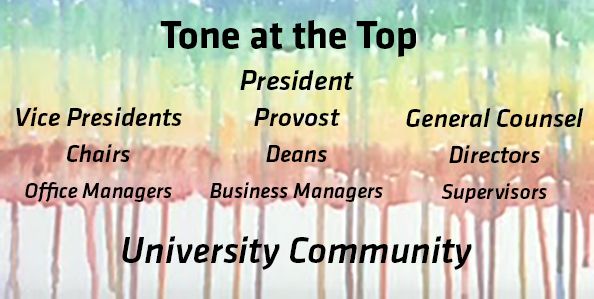Tone at the Top provides the foundation for an organization's control environment. But Tone at the Top does not come only from top management. There is a trickle-down effect that can originate from many positions. You set the tone in your area of influence.
Laying the Foundation
To illustrate how a system of internal control works, we first used a pyramid to show how the five components of internal control connect and work together as a system.

An organization's control environment sets the tone of an organization. It's the factor that most influences the control consciousness of its people and provides the foundation for all other components of internal control.

Tone at the Top comes from many areas of influence in an organization. The trickle-down effect of the attitudes communicated can originate from many diverse positions.

The trickle-down effect does not always start with the president, provost, or one of the vice presidents.
Even though an organization's senior management is most prominently visible, employees also look to the example set by their immediate leaders for direction.
Leadership begins with your behavior. People gravitate toward the standard you set, not the standard you request.
James Clear, author of "Atomic Habits"
Deans, chairs, directors, and other leaders set the "Tone at the Top" for their area of responsibility. Contrast the difference in our video:
More than anything else, the actions of people in authority establish an organization's control environment.
It is the attitudes and habits of those in charge that set the tone and establishes a culture of integrity.
Ethical Nudges
In the first vignette, the department head says she knows the bonuses are contrary to policy. But she's going to do it anyway because it's within budget.
Does her behavior imply ignoring policies and procedures is acceptable when inconvenient? Contrast her approach with the second, where the new department head emphasizes accountability.
Infusing accountability is an ethical nudge advocated by Sreedhari Desai, PhD, an organizational behavior expert at the University of North Carolina.
To provide an example, she explains how asking for itemized bills, rather than accepting a total amount due at face value, infuses accountability. Dr. Desai describes ethical nudges as subtle, proactive, non-coercive ways of leading people down moral pathways. Even the slightest of nudges can be effective.
Her experiments have shown that employees make better ethical decisions when office walls have pictures of aspirational people or emails have moral quotations at the end. Similarly, signage and messaging about vaccinations and masking are other examples of ethical nudging.
Ethical nudges may seem inconsequential. But compare their results to the first department head in our video, whose actions and related trickle-down effects undercut the control environment in her area.
What examples of ethical nudging have you seen at WSU? What have you done to establish, nudge, or boost the control environment in your area of influence?
Small nudges can create ethical behavior | Sreedhari Desai, UNC at Chapel Hill

